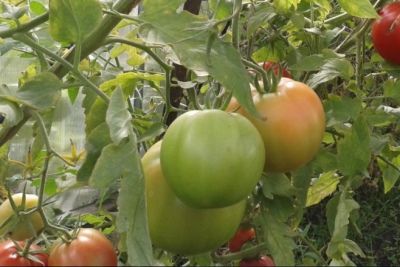
- Authors: Gavrish S.F., Morev V.V., Amcheslavskaya E.V., Degovtsova T.V., Volok O.A.
- Year of approval: 2015
- Category: grade
- Growth type: indeterminate
- Appointment: fresh consumption, for ketchup and tomato paste
- Ripening period: mid-early
- Ripening time, days: 116-120
- Growing conditions: for film greenhouses, for greenhouses
- Bush size: tall
- Bush height, cm: 150-200
Tomato is one of the favorite and popular vegetables. It is used in different ways in cooking. Tomato Babushkino basket deserves special attention. It is not difficult to grow, producing very large and tasty fruits. Such a plant can be grown not only in the garden, but also on the balcony of the apartment.
Description of the variety
The plant is of an indeterminate type, that is, without an end point of growth. In the process of development, the bush must be formed. The bushes are tall, the height is 150-200 cm, they must be tied up. Leaves of medium length, green. 4-6 fruits are formed on one hand.
Basically, the variety is grown in film greenhouses, but it is also possible in the open field. Growing conditions depend on the climate of the region. Culture is very resistant to harsh external factors. Calmly tolerates a drop in temperature and prolonged drought.
The tomato is suitable for independent reproduction. Tomato Babushkino basket is a variety, not an F1 hybrid, so you can collect your seeds. For this, well-ripened fruits are chosen at the end of the season.
The main qualities of the fruit
Tomatoes are very large and fleshy. One fruit can weigh up to 250 g, but there can be more weighty specimens weighing 500 g. Their shape is flat-round, slightly flattened. There is a slight ribbing near the peduncle.
The color of ripe tomatoes is red, with a pink tint. The skin is dense, the flesh is sugary.
Taste characteristics
Excellent taste with concentrated tomato aroma, slight acidity may be present. Due to the large amount of dry substances in fruits, they can be stored for a long time without losing their presentation for up to 2 months.
Their purpose is universal. Basically, Babushkino's basket is used in the preparation of sauces, ketchups, pastes and mashed potatoes. Small tomatoes are suitable for preservation.
Ripening and fruiting
It is a mid-season variety. Fruits begin to ripen on the 116-120 day after germination. For full ripeness, the plant needs 3.5-4 months from the day of sowing the seeds. Harvested from July to August. The tomatoes are picked when fully ripe or slightly unripe.
Yield
High-yielding species. 3-4 kg of fruits are obtained from one bush, 10-12 kg are harvested from a square meter.
The timing of planting seedlings and planting in the ground
Seeds begin to be sown 1.5-2 months before transplanting to a permanent place, around the end of March. The soil should be fertile, loose, capable of retaining moisture well. Before sowing, the soil is warmed up, this will accelerate the process of seed germination. Also, they need to be watered only with warm water for good development and protection from diseases.
Until the tomatoes begin to sprout, they are in a warm place under the film. The variety responds positively to the application of mineral fertilizers. When 2 full-fledged leaves appear on the seedlings, they dive to stimulate the growth of the root system and prepare the planting material for further transplantation to a permanent place.
Hardening is a prerequisite for good development. It is necessary to carry out this procedure gradually, reducing the temperature every day and prolonging the time the seedlings are in the fresh air.
By the end of April - beginning of May, the plant will have 6-8 full leaves, and then Babushka's basket is ready for transplantation to a permanent place. Before planting, you need to prepare the holes, apply fertilizer in the form of humus or compost, water abundantly.
In the case when the seedlings are strongly stretched, they are planted at an angle. After planting, for the first few days, tomatoes need to adapt to new conditions, so they are not touched, watered or fed. Only when new young leaves appear, you can start the basic care of the agricultural crop.

Growing tomato seedlings is an extremely important process, because it largely depends on whether the gardener will be able to harvest at all. All aspects must be taken into account, from seedbed preparation to planting in the ground.
Landing scheme
Since the plant is quite powerful, spreading and tall, the following planting pattern is observed - 40x60 cm.

Growing and care
Indeterminate varieties need proper care for good growth and fruiting. The bushes must be formed, leaving 1 stem, the rest are removed, like the stepsons. Due to the fact that the plant is tall, it is tied up, and the brushes with large fruits are strengthened. Otherwise, it will lead to a breakdown of the branches.
Top dressing is an important component in the development of Babushkino's tomato basket. It is necessary to apply organic and mineral fertilizers often, especially potassium, magnesium and phosphorus. Then the fruits will ripen evenly.
Watering is required in moderation, but the moisture in the soil must be constantly monitored. Its excess leads to cracking of the fruit. Hilling, loosening of the soil and weeding are also carried out.
Disease and pest resistance
Differs in persistent immunity to many infectious diseases, pests practically do not infect bushes. For preventive purposes, the plant can be treated with special preparations during the flowering period.




A plant needs different micronutrients at each stage of growth. All fertilizers can be divided into two groups: mineral and organic. Folk remedies are often used: iodine, yeast, bird droppings, eggshells.
It is important to observe the rate and period of feeding. This also applies to folk remedies and organic fertilizers.



























































































